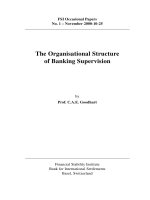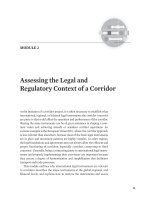Lecture Legal and regulatory aspects of banking supervision – Chapter 8
Bạn đang xem bản rút gọn của tài liệu. Xem và tải ngay bản đầy đủ của tài liệu tại đây (75.5 KB, 42 trang )
Session:
EIGHT
MBF-705
LEGAL AND REGULATORY
ASPECTS OF BANKING
SUPERVISION
OSMAN BIN SAIF
Summary of previous session
•
•
•
SECTION 2:
REGULATING BANK CAPITAL
ADEQUACY
–
What is Capital Adequacy
–
Regulations
–
5C’s of Credit
Regulatory Capital
–
Tier 1 Capital
2
Summary of previous session
(Contd.)
•
General Provisions
•
Hybrid Debt Capital Instrument
•
Sub-ordinated term debt
•
Different international implementations
3
Agenda of this session
•
•
BASEL I
–
Background
–
Main Framework
BASEL II
–
Background
–
Objective
–
The accord in operation
–
The three pillars
4
•
BASEL I
5
Basel I
•
•
•
Basel I is the round of deliberations
by central bankers from around the world,
and in 1988.
The Basel Committee on Banking
Supervision (BCBS) in Basel, Switzerland,
published a set of minimum capital
requirements for banks.
This is also known as the 1988 Basel
Accord, and was enforced by law in
6
the Group of Ten (G-10) countries
in
Basel I (Contd.)
•
•
•
Basel I is now widely viewed as
outmoded.
The world has changed as financial
conglomerates, financial innovation and
risk management have developed, and a
more comprehensive set of guidelines,
known as Basel II, are in the process of
implementation by several countries.
Basel III was developed in response to
7
the financial crisis.
Background
•
•
The Committee was formed in response to
the messy liquidation of a Cologne-based
bank (Herstatt Bank) in 1974.
On 26 June 1974, a number of banks had
released Deutsche Mark (German
Mark) to the Herstatt Bank in exchange for
dollar payments deliverable in New York.
8
Background (Contd.)
•
On account of differences in the time
zones, there was a lag in the dollar
payment to the counterparty banks, and
during this gap, and before the dollar
payments could be effected in New York,
the Herstatt Bank was liquidated by
German regulators.
9
Background (Contd.)
•
This incident prompted the G-10 nations to
form towards the end of 1974, the Basel
Committee on Banking Supervision, under
the auspices of the Bank of International
Settlements (BIS) located
in Basel, Switzerland.
10
Main framework
•
•
Basel I, that is, the 1988 Basel Accord, is
primarily focused on credit risk and
appropriate Risk Weighting of Assets.
Assets of banks were classified and
grouped in categories according to
–
credit risk,
–
carrying risk weights of 0% (for example
cash, bullion, home country debt like
Treasuries),
–
11
Main framework (Contd.)
•
The Tier 1 Capital Ratio =
–
•
The Total Capital Ratio =
–
•
Tier 1 Capital / All RWA
(Tier 1 + Tier 2 + Tier 3 Capital) / All
RWA
Leverage Ratio =
12
Main framework (Contd.)
•
Banks are also required to report OffBalance Sheet Items such as Letters of
Credit, Unused Commitments, and
Derivatives. These all factor into the Risk
Weighted Assets.
13
Main framework (Contd.)
•
Since 1988, this framework has been
progressively introduced in member
countries of G-10, currently comprising 13
countries, namely,
–
Belgium, Canada, France, Germany, Italy,
Japan,
Luxembourg, Netherlands, Spain, Sweden, S
witzerland, United Kingdom and the United
States of America.
14
Main framework (Contd.)
•
Most other countries, currently numbering
over 100, have also adopted, at least in
name, the principles prescribed under
Basel I. The efficacy with which the
principles are enforced varies, even within
nations of the Group.
15
•
BASEL II
16
Basel II
•
Basel II is the second of the Basel
Accords, (now extended and effectively
superseded by Basel III), which are
recommendations on banking laws and
regulations issued by the Basel
Committee on Banking Supervision.
17
Basel II (Contd.)
•
Basel II, initially published in June 2004,
was intended to create an international
standard for banking regulators to control
how much capital banks need to put aside
to guard against the types of financial and
operational risks banks (and the whole
economy) face.
18
Basel II (Contd.)
•
•
One focus was to maintain sufficient
consistency of regulations so that this
does not become a source of competitive
inequality amongst internationally active
banks.
Advocates of Basel II believed that such
an international standard could help
protect the international financial system
from the types of problems that might
arise should a major bank or a series
of
19
Basel II (Contd.)
•
•
In theory, Basel II attempted to accomplish
this by setting up risk and capital
management requirements designed to
ensure that a bank has adequate
capital for the risk the bank exposes itself
to through its lending and investment
practices.
Generally speaking, these rules mean that
the greater risk to which the bank is
exposed, the greater the amount20of capital
Basel II (Contd.)
•
Politically, it was difficult to implement
Basel II in the regulatory environment prior
to 2008, and progress was generally slow
until that year's major banking crisis
caused mostly by
–
credit default swaps,
–
mortgage-backed security markets and
similar derivatives.
21
Basel II (Contd.)
•
As Basel III was negotiated, this was top of
mind, and accordingly much more stringent
standards were contemplated, and quickly
adopted in some key countries including the
USA.
22
Objective
•
•
•
•
The final version aims at:
Ensuring that capital allocation is more
risk sensitive;
Enhance disclosure requirements which
will allow market participants to assess the
capital adequacy of an institution;
Ensuring that credit risk, operational
risk and market risk are quantified based
on data and formal techniques; 23
Objective (Contd.)
•
•
Attempting to align economic and
regulatory capital more closely to reduce
the scope for regulatory arbitrage.
While the final accord has at large
addressed the regulatory arbitrage issue,
there are still areas where
regulatory capital requirements will
diverge from the economic capital.
24
The accord in operation
•
Basel II uses a "three pillars" concept –
–
minimum capital requirements (addressing
risk),
–
supervisory review and
–
market discipline.
25









